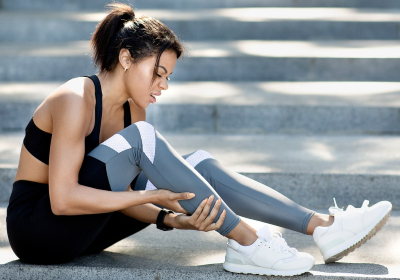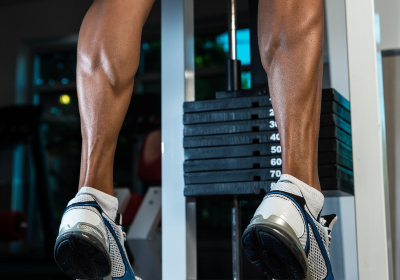VIDEO
Ankle Jumps
- Hips
- Calves
- Ankles
Level:Beginner
Trainer:Nick Taylor
Equipment:No Equipment
This exercise will help you to improve your balancing skills. Just stand straight with your hands by your sides, your feet hips-wide apart. Then bounce off the floor in quick and repetitive move. Repeat the movement untill the set is complete.
save to ...
RECOMMENDED FOR YOU
ARTICLES
Our feet and ankles are one of the most important elements of the locomotor system: without them we can neither stand, walk, run, nor kick someone in the face. Unfortunately, their condition is very often neglected.
Strong and flexible legs provide the basis for stable movement and are of primary importance for performing our daily activities without pain or strain.
The ankle is a block-shaped joint formed by the articular surfaces of the distal ends of the tibia and fibula and the articular surface of the Talus block. Both tibia bones are connected by ligaments and form a kind of fork covering the upper and lateral surfaces of the talus body. The articular sac is reinforced by ligaments.
Many of them connect the bones to each other to provide stability, along with various muscles from the calf to the small tendons that move your toes.
The posterior aspect of the ankle is reinforced by the Achilles tendon, the strongest and most powerful muscle in the human body, which originates at the fusion of the calf and the cambal muscles and is connected to the calcaneus tuberosity.
The ankle joint has to support the weight of the human body and ensure that it is properly distributed when you walk. Therefore, the strength of the ligamentous apparatus, cartilage, and bone tissue is important.
Often people complain of tightness in the muscles of the legs and especially the lower leg. If the small muscles are too weak to keep the foot in the right position, the body responds by increasing tension, elsewhere, in the larger muscles. This leads to tightness in the shin and ankle. Stretching can help for a while, but in the long run, only strengthening the foot is the optimal solution.
Surely everyone who knows about running firsthand knows the importance of strengthening the ligaments of the foot and ankle. Another thing is that sometimes it's hard to spare even 5-10 minutes of training for foot exercises: we get dressed, tie our shoelaces - and run out into the street. That's a pity. After all, good elastic ligaments reduce the risk of foot pain.
Properly fitting shoes is a necessary but not sufficient condition for proper body alignment during running and after training. The ligaments and muscles of the foot can only be strengthened by special exercises.
Read more
The hips are some of the strongest muscles in the human body. They keep the torso upright, control the hip and knee joints, and are engaged during various activities and even at rest. Their proper functioning is extremely important, and anyone should know how they function.
The muscles located on the hip are involved in both hip and knee movements, providing different positions of the hip in space depending on the proximal or distal support. Topographically, the hipі are divided into three groups. The anterior group includes the flexors: the quadriceps and the tailor muscle. The medial group consists of the hip drive muscles: the comb, the long, short, big adductor, and the thin muscle. The posterior group includes the hip extensors: biceps femoris, semitendinosus, and semi-perineal.
The lateral outer and inner thigh muscles are considered antagonistic pairs: while one group is working, the other group relaxes. The abductors, including the middle gluteal, small gluteal, thigh broad fascia tensor, pear, and tail muscles are responsible for your leg movements from the middle of your body.
Essentially, whenever you take a step to the side or turn your foot on the bed, you are activating the abductors. The inner thigh muscles, particularly the large adductor, small adductor, short adductor, and long adductor muscles perform the opposite task, working whenever you move your leg toward the center of your body.
Strong and injury-resistant athletes have well-trained hip muscles. This is very important when it comes to fast sports with a lot of lateral movements, such as tennis or basketball, but also when you want to work out without pain. If your goal is to strengthen your hip muscles, which is really important, but you don't have your favorite leg workout, we will share some great exercises with you.
Wide Squats. Every leg workout should include different variations of squats. This exercise targets the lower body, including the inner and outer thighs. But to really engage your thigh muscles, you should do deep squats with your legs turned outward.
Sumo Deadlift. The Sumo deadlift is based on a similar leg position as in the wide squat. However, it is the external rotation of the thigh muscles that results in increased involvement of the inner and outer thighs.
Side Leg Raises. A 2005 study published in the Journal of Orthopedic and Sports Physical Therapy found that side leg raises without weights are just as effective as other weighted exercises.
Side Leg Pull-Ups. The pull-up exercise can be done anywhere because you don't need anything but a comfortable mat. This is a great exercise that you can add to your daily home workout routine.
Read more
Building up the calf muscles and make your legs beautiful is quite difficult, but possible. It is difficult because the legs are used to constant strain (usually people walk a lot). And it becomes possible thanks to the proven exercises, which can effectively train this group of muscles. In this article, we will take a detailed look at the anatomy of calves, their functions, and exercises that you can do to help make them stronger.
The calf muscle is the most superficially located muscle of the lower leg that crosses two joints: the knee and ankle. Like the biceps of the shoulder, it consists of two heads: medial (located closer to the inside of the tibia) and lateral (located closer to the outside of the tibia). It is interesting to note, that about 5.5% of Japanese and about 3% of people of other nationalities may have the 3rd head of the calf muscle, which attaches from above between the fixation sites of the medial and lateral heads, and may connect from below either to the lateral head (less often) or to the medial head (more often).
The primary function of the calf muscle is to lift the supporting leg, which causes a person to move forward along with flexion of the knee and ankle joints. Running causes a lot of stress on the calf muscles that is why many sprinters face the problem of calf pain.
There are also other functions of the calf muscle.
The calf muscle is involved in the plantar flexion of the foot, which occurs during walking, running, or cycling;
It is also activated during flexion of the leg at the knee joint;
It participates in the supination of the foot (its outward rotation);
The calf muscle takes part in the stabilization of the knee and ankle joints and also helps to keep the balance in the upright position of the body.
There are many reasons that can cause calf pain. And to prevent this unpleasant situation, the following rules should be followed:
running at a comfortable pace;
warming up before running and stretching after training;
comfortable shoes suitable for running;
a smooth transition from running to stopping after a step;
drinking plenty of water after the workout;
a warm shower/bath and a massage to relax the muscles.
The reasons why the calf muscles are not as developed as you would like them to be could be the following:
too much training aimed at working out this muscle group;
not enough exercise;
the wrong set of exercises.
It is necessary to choose the right exercises for the calf muscles. It must be noted that the surface muscle is worked out in a standing position, and the cambalic muscle in a sitting position. To train as effectively as possible, it is necessary to load both muscles.
And the last, but not the least advice: do not try to achieve serious results by performing endless repetitions, such as deadlifts. The main secret of how to pump up the calf muscles is heavy training with weights. It is recommended to train your calves no more than 2 times a week.
Read more
SAVE TO ...



